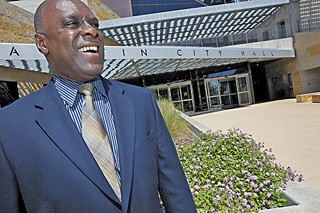Attempting to Comply
With a new name and a new boss, Code Compliance tries to become more 'people-friendly'
By Richard Whittaker, Fri., Sept. 30, 2011
No one ever said that Code Compliance officers had to be popular.
They are effectively the cops of zoning ordinances; if they turn up at your door, it is rarely a good sign. So after almost three decades of dealing with noise regulations, off-road parking, high weeds, and building permit violations, Austin's new Code Compliance Director Carl Smart should expect to take the rough with ... the slightly less rough. Prior to Austin, he headed up code compliance and neighborhood conservation departments in Fort Worth, Atlanta, and Gainesville, Fla. Compared to those cities, he said, Austin "has some unique characteristics, like music venues and special events like the [Austin City Limits] Music Festival." On top of that are the unusual pressures of being a major college town and a capital city, "but still, it's neighborhoods; it's people; it's community," he said.
Austin's Code Compliance Department is essentially a new entity. With 69 staff members and an annual budget of $10 million, it also has a lot of ground to cover in a city heading quickly toward a million in population. The agency's genesis was in 2001, when the city decided to let Solid Waste Services (which just changed its name, along with its avowed purpose, to "Austin Resource Recovery") handle all weeds, junk, and litter dumping complaints. In 2005, housing and zoning enforcement was added to that workload, coinciding with the formation of the Code Enforcement Division. Then in 2009, as part of an overhaul of the city's waste management programs, council decided to make Code Enforcement a new agency – the "Code Compliance Department" – reporting directly to the assistant city manager for transportation.
That change in affiliation and title reflected a new direction for handling code violations, but it was not going to be instantaneous. Former Solid Waste Services chief Willie Rhodes became the Code Compliance's first director, and while he was regarded as a safe pair of hands – no one expected either a major office shake-up or a long tenure for Rhodes – his old-school approach to waste management became out of step with modern best practices for trash and recycling, especially with the delays over building a city-owned materials recovery facility. Rhodes was shuffled sideways, pending his retirement earlier this year.
The Cycle of Enforcement
However, for an otherwise low-profile agency, Rhodes' tenure certainly gave council a few black eyes and bad headlines: the closure of the Enchanted Forest and the Cathedral of Junk; the recent war over unpermitted additions to houses in the Fairview neighborhood, many of them preceding the current owners; the threat to the East Austin Studio Tour (see "East Austin Studio De-Tour," July 15); and the fight with Coronado Hills homeowner Laura Croteau over whether her nationally certified Wildlife Habitat yard was too unruly (see "From Shrub to Nub," July 8). In each of these cases, the office came under heavy scrutiny and its officers faced severe criticism. That may all be part of the inevitable frictions as Austin shifts from a college town with a laissez-faire attitude to a more modern and more strictly regulated city. All cities undergo that transition; Smart described code enforcement as "a cyclical-type industry. You have times when elected officials want really strong code enforcement." That was a lesson he learned after Hurricane Andrew devastated Florida in 1992. "Everyone looked at the codes and said, 'Wait a minute, we need stronger, more strict enforcement of codes.' So Florida changed its code laws. It got stronger and stricter and enhanced its enforcement of those laws, putting in place code enforcement boards, that kind of thing. But after a while, things were going well, and they start to slack off and say: 'We don't need that much code enforcement. Ease up some.'"
For now, Smart is in an unusual position. As the first real head of Code Compliance, he gets to put his signature on its operational structure. At the moment, his inspectors are assigned to specific areas of town. Smart said, "When a problem comes up, a lot of times they already know about that particular property, they've seen it, they've passed it in their day-to-day operations, so they can respond and deal with it effectively." However, in October, he and his senior staff will be meeting to discuss the department's structure, and part of the planning will concern what additional specialist units may be required. That will also require a close examination of relations with other departments, from Planning and Development Review (which issues the permits that Code Compliance enforces) to Parks and Recreation (which clears up foliage when Code Compliance asks it). Said Smart: "It really takes that collaborative effort to get that right. What's the right size of the staffing in order to do that? That's something we have to study."
However, for all the opportunities that Code Compliance affords him, it is an agency that comes with a lot of baggage. In 2010, city auditor Kenneth Mory published a report that was not exactly a clean bill of health. While he applauded the department for how it dealt with neighborhood groups, he found serious problems with core operational procedures. Complaints did not always result in an initial inspection; cases were insufficiently documented, and the reliability of the data was questioned; and, most worryingly, Mory's staff found that "code violation case investigation and resolution practices often differed from CCD policies and procedures" and varied from case to case.
Just before Smart took office in July, Mory published a more positive follow-up. He concluded that the majority of recommendations detailed in the 2010 audit had been fully or substantially implemented. However, three measures were classified as only "underway." Code Compliance still needed to establish a better relationship with the city's Housing Authority. It still needs an integrated case management system. And most importantly, it still needs to establish proper monitoring of its own inspectors to see if they are complying with the department's own rules. It was not just that staff did not always follow the code, but a more general judgement that, as an enforcement-first entity, Code Compliance staff sometimes lacked interpersonal skills.
Put bluntly, they were just not very good with people.
In part, that was why the new department had been named "Code Compliance" rather than "Code Enforcement": to kick-start a culture change. Part of the auditor's 2010 recommendation was that the department create a training program integrating city codes and industry best practices. That system is now in place, and residents should begin to see its impact. "A code enforcement officer has to have two skills," Smart said. "You've gotta know the codes and have the technical skills to handle the codes and what you see out in the field, but you've got to have those interpersonal skills to be able to communicate with all kinds of people."
Hoping for Common Sense
There remains a very real and continuing concern that Code Compliance too often becomes a weapon in feuds, that residents abuse the anonymous tip system to harass their neighbors. Smart acknowledges that some people have worked out how to game the system – which requires the department to investigate any complaint, no matter how accurate or substantive – but he says there are checks and balances. The operators at 311 can recognize callers who phone in streams of random complaints, while his officers should be able to recognize when they are being called repeatedly on wild-goose chases to the same address. However, at least for the present, he stands by anonymous tips rather than moving to a system under which the city requires identification but promises to protect a complainant's anonymity. He said, "You could put in a system where you have to have a name, an address, something like that, to show that you live in the neighborhood or you live in the city of Austin, before we'd take that complaint." However, he added: "I think the answer initially is just that we try to identify those instances of abuse and deal with those individual situations. But if we start to see that that abuse is widespread then we need to change our process."
The core challenge for Smart and his officers was summed up in Mory's 2010 report: "Enforcement officials often face complex problems with a variety of conflicting interests, with resultant pressures from elected officials and community groups to punish violators swiftly, while often receiving complaints that officials are harsh, overzealous, or bureaucratic." A year later, the situation has changed a little. While Mory still praised the department's neighborhood outreach, several council members, including Chris Riley and Mike Martinez, have been increasingly concerned about overzealousness. While there will always be citations and municipal court hearings, Smart wants to move away from "drive-by code enforcement" and instead become more proactive and preventative, with programs like "Stop and Knock." He explained: "It's just that. Stop your car, knock on the door, talk to somebody." That may require more staff – and Smart said department size will be an inevitable part of the strategic decisions – but it should save court costs and ease neighborhood tensions. Smart said: "A lot of times, by the time you can get a notice issued, the problem's been taken care of just because now they're aware. 'Oh, I didn't realize that was a code, so now I'll take care of that problem.' So that's good, effective code enforcement."
That perspective may please Mayor Lee Leffingwell, who said he's "hoping for commonsense solutions and an innovative approach to problems." For Smart, the best result may be for everyone to forget that the office was ever called Code Enforcement. He said: "We're here to ensure compliance with the code and make the quality of life better in the neighborhoods for everybody. So as long as we can focus on the goal, everything else is secondary."
Got something to say on the subject? Send a letter to the editor.











